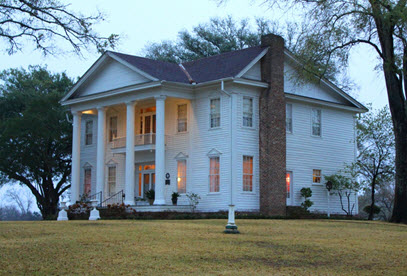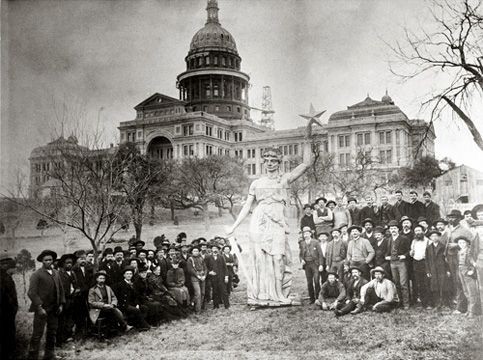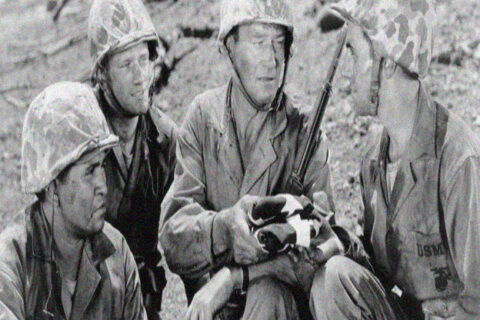The Reconstruction of the Lone Star State proved a chaotic time for Texans, waxing and waning between moderate and Radical control. The Reconstruction of the State of Texas stands alone as a unique case, both in its roots and the events of Reconstruction itself, yet little of the history of the tumultuous era remains within contemporary discourse. This essay will examine the economic, social, and political Reconstruction of the Lone Star State.
Fairing economically better than most of Dixie during and after the War, Texas stood on a firmer foundation at the outset of the Confederacy’s defeat. Many Planters moved their slaves and cattle to Texas to protect their property from the destruction of war. Additionally, Texas remained largely isolated from the destruction and macabre violence of the War Between the States, having thwarted any attempts of invasion by the Union Army under the Confederate Department of the Trans-Mississippi commanded by General Kirby Smith. Upon the dissolution of the Confederate Government, any and all investments in Confederate kismet ceased to exist, leaving many within the eastern region of the state penniless. Additionally, treasury agents acted corruptly when dealing with the monetary affairs of Texans. And, the state, under forced obligation, relinquished what was left of its governmental and monetary holdings to the United States government. Lastly, many Southerners, particularly from the Deep South, began moving en masse to the state to escape the economic problems of the region. While the focus of much of the governing legislatures during the era focused, at least moderately, on the economic future of the state, their primary focus was on that of the political restructuring, and later social rehabilitation.

Lacking in rigidity describes the politics of Reconstruction Texas. Much like most other Southern states during the Presidential Reconstruction period of 1865-1867, Texas’ legislative body lied primarily within the moderate camp, albeit sympathetic to the well being of their Southern constituents. Texas had a number of factions within the legislative body which generated considerable infighting until the Reconstruction Acts were passed in 1867. Initially, the legislature was comprised mostly of moderates, with radicals and secessionists existing loudly within the fringes. The initial constitution was fairly moderate and instituted Black Codes, as did many other Southern states. The legislature was led by James Throckmorton, a Southern Unionist who still served within the Confederate Army anyway, as well as a Democrat. Governor Throckmorton faced opposition from all sides, including the military commanders in the region and was eventually ousted by the Radicals following the implementation of the Reconstruction Acts. His tenure focused on restoring civility and law to the land, as well as, ensuring a worthy constitution was adopted for the state. Additionally, many positions for public officials were given to Confederate sympathizers and veterans due to a lack of quality candidates among the moderates and Radicals.
Despite being successful in his goals, as well as, an objectively good governor, the Radicals eventually replaced Throckmorton with Elisha Pease in 1867. Pease, an ally to the Radicals and a former Governor of Texas, worked as a puppet of the military rulers. They immediately began deconstructing all progress made under the former governor, allowing violence to run rampant throughout the state. His administration, alongside Radical General Sheridan, the commander of the 5th Military District, purged all public officials not sympathetic to the Radical cause but encountered difficulty in replacing them, as so few Texans held the same views. The lawlessness began increasing at an astonishing rate following these actions; as a result, the Radicals’ outcries against the violence in the state grew louder. Eventually, Sheridan was replaced by General Winfield Hancock, a moderate, who eventually resigned his position due to relentless propaganda and blame for the uptick in anarchic behavior.
Eventually, another constitutional convention was organized in 1868. The first assembly of the session lasted 92 days and close to nothing was accomplished, other than infighting. Radicals were a minority but generally remained a nuisance and were quite crafty. One notable political move they advocated for, and arguably their only quality idea in the long term, involved avid support of Texas divisionism, a concept which had not been discussed since Texas’ initial admission to the Union. This topic proved controversial and deeply divided moderate Republicans from the Radicals. The second session accomplished a bit more. In total, the convention lasted five months and costed $200,000 with only a month actually being spent on drafting the state constitution.
The Radicals found much more success in 1869 during the next state election with leftist Union Officer Edmund Davis rising to governorship. Under Davis, Radicals finally reigned supreme in the land and passed all the laws they pushed for. The constitution, 13th amendment, and 14th amendment were all ratified, and Texas was readmitted to the Union. The laws passed during this period established what would become the Texas National Guard and the Texas State Police, both under the absolute control of Davis, a state militia, and various firearms regulations. Much of the legislation passed during this tenure was made possible by Davis arresting and imprisoning his opposition in the state government for a few weeks. Davis heavily subjugated the state with his only notable positive qualities being his honesty about his intentions and his fiscal responsibility. The state guard and police abused their powers incessantly and often filled their ranks with Negroes, much to the chagrin of Texans. Davis would ultimately be defeated by Democrat Redeemer and Confederate veteran Richard Coke in the 1874 election. Davis, unwilling to accept defeat, barricaded himself in the capitol building, which Democrats then had to infiltrate via climbing the building. Once Davis relinquished the governor’s seat, Coke took his place as the Governor of Texas, bringing the Radical reign of terror in the state to an end.

Though Texas suffered greatly economically and experienced constant political turmoil, society of the state at large produced the most concerning of the circumstances to engulf the state. Resentment and lawlessness often characterized the people of Texas, having been overwhelmingly supportive of the secessionist Lost Cause, and usually resulted in waves of angry furor. Texas was one of, if not the only, state to put secession to a popular vote, and the populace, with the exception of the Germans in south Texas, voted overwhelmingly in favor of joining the Confederacy. That sentiment only grew stronger during the War and Reconstruction; carpetbaggers and Radicals took full advantage of the resentment of Texans. They consistently reported the negative feelings and hostility they faced while governing the state. While Texas initially faced a spike in crime immediately following the War, the state’s crimes decreased under Throckmorton and only continued to grow in number the more Radical the government became.

Though the Ku Klux Klan generally receives the brunt of the spotlight relative to the other militant pro-Southern groups at the time and did pursue its own violent ends primarily in northeastern Texas, the Knights of the White Camellia featured much more prominently in the state, much like the rest of the Lowland Deep South, and it was primarily concentrated in East Texas but reportedly had members as far west as Waco. Thankfully, the struggles of Texans paid off during the election of 1873 with the election of Richard Coke as governor, ensuring Southern Democrat bona fide Texan rule in the state until the 1950s. Unlike the rest of the Lower South, Texans generally found success at the voting polls during the election of 1873 based off a movement generated by both secessionists and moderates uniting behind their mutual loathing of Davis. However, some did utilize intimidation, but the election relatively happened without the use of extreme force.
Texas, keeping in trend with the rest of the Lower South, faced notably laborious hardships during the Reconstruction Era. Though its economic stance fared better than much of the rest of the “Original Seven,” its political and social turmoil remained relatively on par with the adversity the Deep South faced. Fortunately, Texans would Redeem their state via sheer willpower at the polls, though later than that of the Upper South, and the state would then enter an age of prosperity following the Compromise of 1877 and the beginning of the Jim Crow Era.
“The White people of the South are the greatest minority in this nation. They deserve consideration and understanding instead of the persecution of twisted propaganda.” –Strom Thurmond






We take a year of Texas History in seventh grade. The North’s guerilla war against the South and Texas, Secession, the War, and Reconstruction, take up several chapters in the text book.
The Yankees were not the heroes of the story. They were heinous villains and enemies.
It must be nice to live in a state where they teach pride in your history.
That was back in 1981, when the Transplant and Mexican invasions were just beginning.
I have no idea what they’re teaching now. However, I note that young people today still have Texas and other Southern flags and symbols on their clothes, vehicles and other in places.
They’re also especially pleased, whenever a Texas sports team beats one from up North.
My wife is a 4th grade Texas history teacher and they just finished teaching holocaust week where the state mandated she teach about the holocaust and a different character profile each day… the characters were
Monday- Anne frank
Tuesday- MLK
Wednesday- Teddy Roosevelt
Thursday- Obama
Friday- Dumbledore from Harry Potter
Texas history is taught still to a certain degree but it’s being destroyed.
Well, as long as they keep mandating the teaching “Constitution Week” everything will continue to be beautiful and wonderful in the Lone Star State.:
https://orthosphere.wordpress.com/2016/09/01/hurray-hurray-its-constitution-day/
That was back in 1981, when the Transplant and Mexican invasions were just beginning.
I have no idea what they’re teaching now.
I was about to say, ‘It’s hard for me to believe that the public schools in any Southern state or state that joined the Confederacy currently teaches pride in its history, or has in several decades.’
I forgot to add that the people in Texas, as opposed to the people of Texas, wish us all to remember to Forget the Alamo.:
https://orthosphere.wordpress.com/2018/01/16/forget-the-alamo/